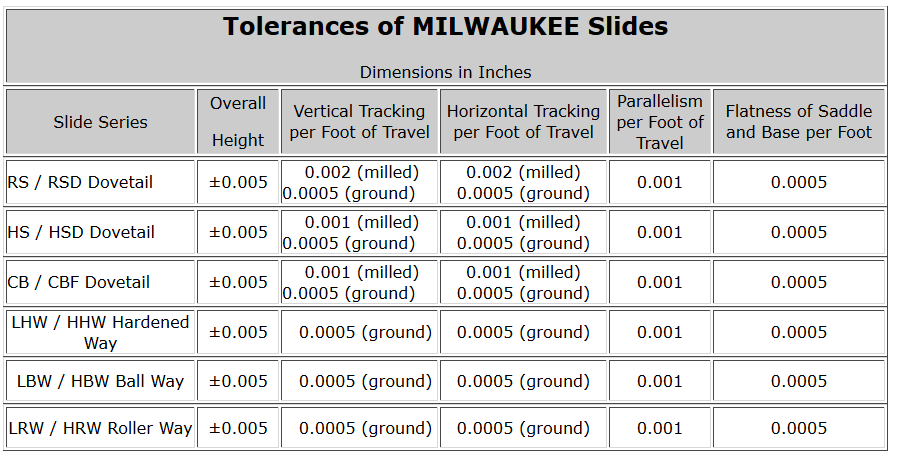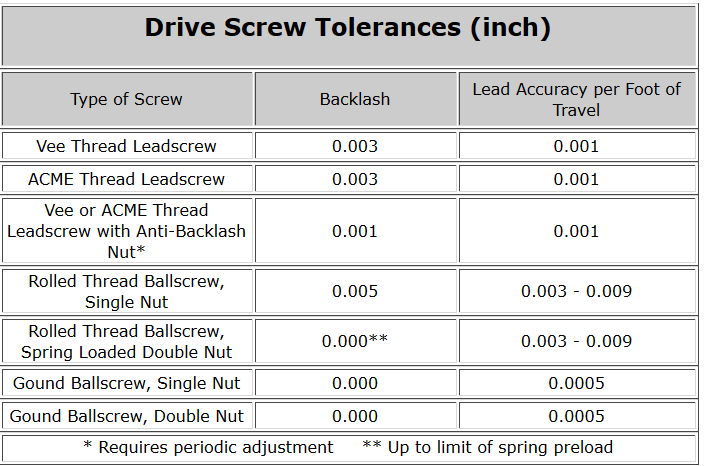Machine Slides
Machine Slide Facts
Construction of MILWAUKEE Precision Machine Slides
MILWAUKEE precision machine slides are precision-designed and manufactured to offer close tracking tolerances and high rigidity to provide accurate linear motion for any application.
Types of MILWAUKEE Machine Slides
Dovetail Slides
Dovetail slides are rugged positioning units that are suited for manual or powered movement. Typically used in positioning applications where occasional movement is required.
Hardened Way Slides
Hardened way slides are designed for production use, where high usage and heavy loads are expected. These slides are designed for years of use with minimal maintenance.

Slide Protection
Way Wipers
Way wipers are designed to wipe contaminants off of the way and base surfaces of slides. The way wipers do not protect the drive mechanism of the slide.
Cavity Wiper
A cavity wiper is designed to wipe out the cavity or area between the ways on a machine slide.It pushes off chips and coolant off of the end of the slide.
Cavity Cover
A fixed or telescoping sheet metal cover with wiper encloses the slide’s cavity to prevent ingress of chips or coolant.
Accordion Way Covers
Made from PVC coated nylon, these covers have stiffeners in every fold. Alternate materials are available for high temperatures or harsh contaminants. Accordion covers require regular cleaning to prevent damage from accumulated debris packing in the folds of the cover, and as such, are not recommended for applications involving heavy chip loads.
Accordion Way Covers with Stainless Laminations
The stainless laminations act as an “armadillo” cover, in that the plates overlap to provide hard protection for the cover. These laminations prevent most contaminants from packing the folds of the cover.
Telescopic Metal Way Covers
This is the best type of protective cover for a machine slide. Telescopic box sections with wipers overlap to seal off the slide. With no folds to collect debris, these covers are suitable for heavy chip loads. Covers can be peaked to facilitate coolant drainage.
Fixed Sheet Metal Covers
Are the simplest and least expensive way to protect ways and drives. A fixed box cover slides back & forth with the saddle. The fixed sheet metal cover does not telescope, so adequate clearance must be provided at the slide end for the travel of the cover.
Slide Drive Mechanisms
None – hand push
Leadscrew
A leadscrew drive consists of a leadscrew, bronze nut, and end support assembly. Leadscrews with efficiencies less than 35% will not normally backdrive, although vibration can cause creeping.
-
- Vee thread – either 20 or 40 threads per inch
- ACME thread -usually 10 threads per inch, others available
This style of leadscrew nut reduces the backlash to approximately 0.0005” minimum. Periodic adjustment is required to maintain the reduced backlash performance.
Ballscrew
A ballscrew is a ball bearing drive screw that uses recirculating ball bearings between the nut and the screw. It offers a mechanical efficiency of 85% or higher. Ballscrew drives consist of the ballscrew, nut housing, and end support with preloaded ball bearings.
-
- Rolled
The rolled ballscrew has a rolled thread and a milled nut. The most cost-effective ballscrew, but largest lead error. Single nut variety has backlash, double nut with spring preload has zero backlash up to the spring preload value. - Ground
A ground ballscrew has a precision ground screw and nut for maximum precision and life. Most types have zero backlash; single or double nut.
- Rolled

Cylinder
A cylinder drive consists of either a pneumatic or hydraulic cylinder, with linear alignment rod coupling, and mounting plate. An adjustable stop rod is provided to limit length of travel.
-
- Pneumatic
MILWAUKEE uses heavy-duty units rated for 250 PSI, requiring lubrication unless specified otherwise. Adjustable cushions are at each end of the cylinder. - Hydraulic
Medium pressure cylinder with adjustable cushions at both ends.
- Pneumatic
Rack and Pinion
A rack and pinion drive consists of a stationary rack mounted on the base of the slide, with a motorized pinion mounted on the moving saddle. Suited for slides with long travels where ballscrews or cylinders are impractical because of their length. Elimination of backlash is possible but is an extra-cost adder.
Slide Accessories
Motor Mount
If a leadscrew or ballscrew driven slide is to be motorized, a motor mount can be provided. A stress relieved steel fabrication, it is precision ground and machined to fit the customer-supplied motor. Motor mounts come with a rigid coupling with keys as standard. Metal bellows coupling is an extra-cost option, and provides for minor misalignment.
Limit Switches
For slides with powered drives, limit switches can be helpful to limit travel and determine position. Two end of travel switches can be used to prevent overtravel, and one “home” switch can be used to determine saddle position during start-up.
A limit switch package includes sealed plunger-style switches with 6′ pigtails, adjustable trip dog rail with trip dogs.
Right Angle Drive
A right angle drive is a right angle gearbox that can be mounted to a leadscrew or ballscrew drive. It allows the handwheel or motor to be mounted at 90º from the slide axis. A right angle drive can be supplied with either a 1:1 or 2:1 ratio.
Way Treatment
Low Friction Bearing Material
Low friction bearing material is a laminate applied to the way surfaces and gib of a dovetail or hardened way slide. The bearing material is grooved for lubrication and precision surface ground. It lowers the coefficient of friction from .23 to .1 lubricated. This allows for a tighter gib setting for a given amount of drag.
Flaked Ways
Flaked ways provide small cavities in the way surfaces of the shorter member for lubricant. This pattern of cavities provides improved lubrication for lower friction and longer life.
Scraped Ways
For extra precision, scraped ways can be provided. This process involves creating a pattern of small divots in the way surfaces of the shorter member to act as lubricant reservoirs. It this way, stick-slip friction (or stiction) can be minimized, also providing longer life. A scraped way surface requires considerably more hand finishing time than a flaked way surface.
Mounting Provisions
All of the following mounting provisions are available on MILWAUKEE slides:
Mounting Holes
Tapped, or drilled and counterbored in the base and saddle. Avoid locating the holes in way surfaces. Per customer drawing, or MILWAUKEE will provide a mounting hole pattern.
T-Slots
Normally require a slide of special height to allow room for the depth of the t-slot.
Key Slots
Usually used to take the thrust from machine spindles.
Sine Keys
Used to install a key without having to mill a slot.
Compounding
Compounding is when two or more slides are to be mounted together. MILWAUKEE uses multiple socket head cap screws to clamp the units together and two hardened dowels to assure alignment.
Gib Designs & Fit
A gib is an adjustable take-up mechanism to adjust the fit of a machine slide. The gib permits adjustment of the fit of the slide over its service life.
Straight Gib
The standard MILWAUKEE design for dovetail and hardened way slides. Consists of a flat tool steel strip acted on by multiple setscews. The fit of the slide is set by tightening or loosening the setscrews. The gib is equal in length to the saddle, and may be pinned in place for extra precision.
Tapered Gib
For extra precision and rigidity, the tapered gib may be used on either a dovetail or hardened way slide. It consists of a steel strip with a taper ground into one side, and a corresponding taper ground into the saddle. At each end of the gib there is a cap screw, and by adjusting the screws against each other, the gib can be moved back and forth, adjusting the fit of the slide.
The tapered gib is 70% more rigid than an equivalent straight gib, for a given size.
Keeper Gib
The keeper gib is used on all MILWAUKEE hardened way slides. Two keeper gibs in each keeper assembly, one at each end, allow the fit of the slide in the vertical direction to be adjusted. The keeper gib is made of high-tensile bronze, and acted on by several setscrews.
Tapered Keeper Gib
Adds the rigidity and precision of a tapered gib design to keeper gibs. Each keeper has two tapered keeper gibs, one at each end.
Fit of Gib
The fit of the gib determines how much internal clearance the slide will have, and also the amount of frictional drag. Machines slides that use sliding friction for force transmission must have a small amount of clearance between the sliding members to permit relative motion. This clearance can be eliminated completely with the gib adjustment, thus locking up the slide, see “Gib Lock”, below. The gibs of MILWAUKEE slides are factory-adjusted to suite most applications, but can be set-up in the field.
Gib Locks – Dovetail and Hardened Way Slides
A gib lock is a mechanism designed to tighten the gib of the slide to lock the slide into a selected position. This can be an adjustable handle suited for manual operation, or a hydraulic cylinder for powered operation. Multiple locks add clamping force additively.
Keeper Locks – Hardened Way Slides
These types of locks are installed in the keepers of hardened way slide. Typically small hydraulic cylinders, they press up against the hardened rail to lock the saddle into position.
Way Locks – Linear Guide Slides
Are either manual or hydraulic locks for use on linear guide slides. The way lock clamps onto the rail of the linear bearing, securing the saddle into position. Multiple locks add clamping force additively.
Lubrication
All MILWAUKEE machine slides are designed to be lubricated with way oil, not grease. All slides (except for RS/RSD2, 3, 4) have lube fittings to the way surfaces and drive nut (if equipped).
Recommended oil: Mobil VACTRA # 2 or equivalent.
For production use, machine slides should be connected to an automatic lubrication system, which monitors reservoir oil level and confirms cyclic operation of the pump. The system should have a 1µm filter, and a screen on the filler of the reservoir.
Corrosion Protection
The main components of MILWAUKEE machine slides are made from cast iron and steel, and rely on a coating of oil for corrosion protection. If greater corrosion protection is required, or if oil cannot be tolerated in the work environment, MILWAUKEE has several options:
Electroless nickel plating
Ferrous components are plated 0.0002-0.0003” thick, providing a barrier to corrosion from oxidation.
Stainless steel construction
For maximum corrosion protection, stainless steel construction is available. This must be used in conjunction with Turcite ® low friction bearing material for dovetail slides.
Aluminum construction
This option is suited for light-duty applications only. The base and saddle of the slide are made from aluminum, anodized, and Turcite ® is applied to the shorter member.
Machine Slide Materials
The standard slide material for base and saddle is class 40 gray cast iron. If steel is required, this can be provided as an option at extra cost.
Aluminum is an option for dovetail and linear guide slides. It is not recommended for precision positioning or heavy application forces.
